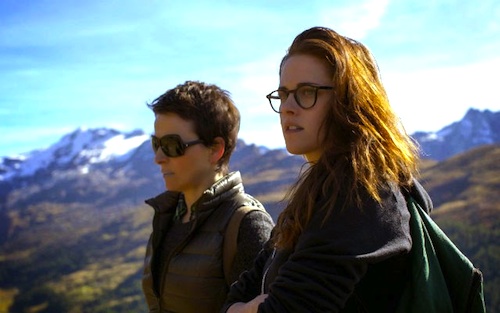By Joe Bendel. Taking stock of German filmmaker Arnold Fanck is a rather complicated business, considering he was a close associate of Leni Riefenstahl. Still, he remains one of the most accomplished mountaineering filmmakers of the silent era, so it is not outrageous when his documentary short Cloud Phenomenon of Maloja assumes a prominent place in Olivier Assayas’s Clouds of Sils Marria, which screens as a Main Slate selection of the 52nd New York Film Festival.
Fanck’s silent film never ceased to fascinate the soon-to-be-late Fassbinder-ish Wilhelm Melchior, who titled his most famous play The Maloja Snake in reference to the serpentine cloud formation it documents. Maria Enders’ career ignited when she appeared in the film version, also directed by Melchoir, playing a ruthlessly manipulative young woman engaged in a lesbian relationship-slash-power struggle with an older, more sophisticated woman. Although many years have passed, she is reluctant to accept the more mature and tragic role, for a variety of reasons rooted in insecurity and superstition (the actress who starred opposite her died shortly thereafter). However, her personal assistant Val thinks it is a fine idea, because of her respect for the innovative director, Klaus Diesterweg, and her prospective co-star, the Lindsay Lohan-esque Jo-Ann Ellis.
Val and Diesterweg apparently prevail, but Enders constantly threatens to pull out of the production. She is profoundly uncomfortable with the different meanings she finds in the text after her reversal of roles. In fact, it seems to speak directly to her relationship with Val, especially when they rehearse her lines. The tabloid circus following Ellis also spooks the extremely guarded Enders.
If the Weinsteins had picked up Clouds, Juliette Binoche would have been an instant Oscar frontrunner. It is a performance of strange and understated power, befitting the character clearly modeled to some extent on herself. The implied self-referential nature of the film thereby makes her scenes with Kristen Stewart’s Val feel even bolder and revealing.
Unlike the clumsy play-that-becomes-real in Polanski’s wildly over-praised Venus in Fur, Assayas stages the uncomfortably charged rehearsal sequences with such subtle ambiguity, we often lose our narrative bearings within the film, despite being on guard against that very contingency. Of course, everyone has known Binoche is one of the best in the business for some time, but the degree to which Stewart matches her intensity is almost revelatory. It is an especially bold performance for her, given the added meta-dimensions, such as Ellis’s affair with a married writer that echoes certain media feeding frenzies Stewart would probably like to forget.

While the film works best as a two-hander, Hanns Zischler is devilishly effective as the older actor with whom Enders once had an ill-advised affair, whereas Chloe Grace Moretz looks the part, but never really adds to our understanding of a hot mess like Ellis. Arguably, the third act is somewhat flat compared to the action that came before, in large measure due to Val’s deliberately mysterious exit. Yet, it is still fascinating to see Binoche’s Enders navigate the world of international celebrity they both know so well. While all signs seem to indicate her time in the spotlight is coming to a close, the Ellises of the world might just be playing Enders’ game after all.
Even with its late pacing issues, Sils Maria is a quite a wry valentine to actresses and the personal assistants who put up with their diva-ness. It is unusual when a film this smart is also so forgiving of human weaknesses. Helmed with considerable sensitivity, it also represents a return to form for Assayas after the messy and somewhat didactic Something in the Air. Recommended for fans of Binoche, Assayas, and Stewart (which really ought to cover just about everyone), Clouds of Sils Maria screens as part of this year’s NYFF.
LFM GRADE: B+
Posted on October 11th, 2014 at 2:45pm.